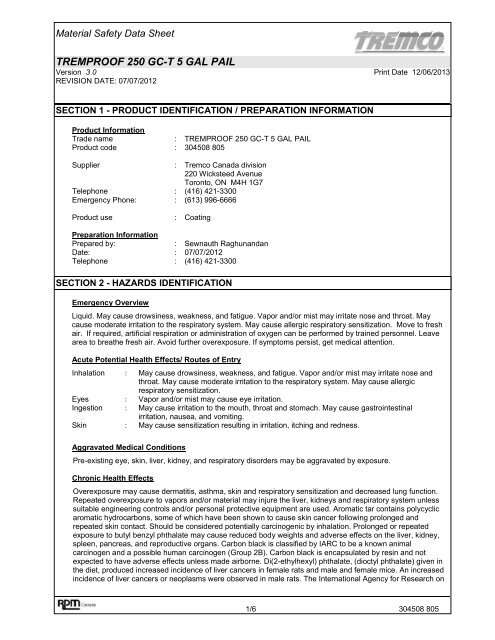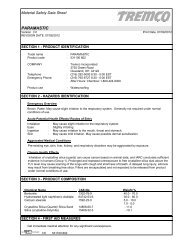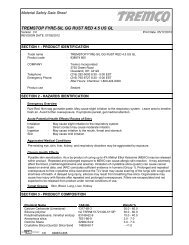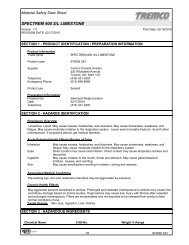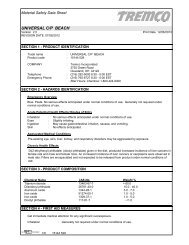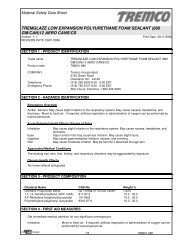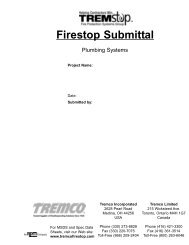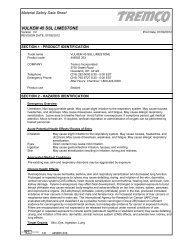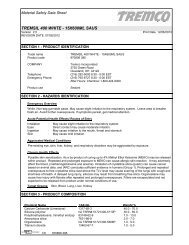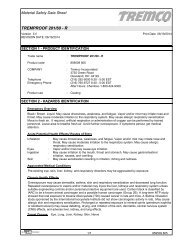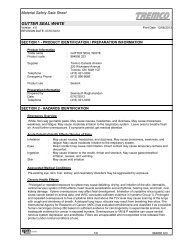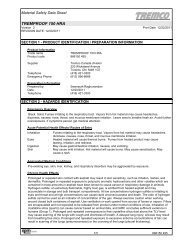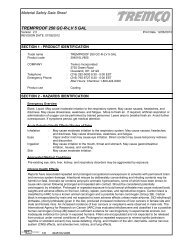TREMproof 250GC-T MSDS - Tremco Sealants
TREMproof 250GC-T MSDS - Tremco Sealants
TREMproof 250GC-T MSDS - Tremco Sealants
Create successful ePaper yourself
Turn your PDF publications into a flip-book with our unique Google optimized e-Paper software.
Material Safety Data Sheet<br />
TREMPROOF 250 GC-T 5 GAL PAIL<br />
Version 3.0 Print Date 12/06/2013<br />
REVISION DATE: 07/07/2012<br />
SECTION 1 - PRODUCT IDENTIFICATION / PREPARATION INFORMATION<br />
Product Information<br />
Trade name : TREMPROOF 250 GC-T 5 GAL PAIL<br />
Product code : 304508 805<br />
Supplier : <strong>Tremco</strong> Canada division<br />
220 Wicksteed Avenue<br />
Toronto, ON M4H 1G7<br />
Telephone : (416) 421-3300<br />
Emergency Phone: : (613) 996-6666<br />
Product use : Coating<br />
Preparation Information<br />
Prepared by: : Sewnauth Raghunandan<br />
Date: : 07/07/2012<br />
Telephone : (416) 421-3300<br />
SECTION 2 - HAZARDS IDENTIFICATION<br />
Emergency Overview<br />
Liquid. May cause drowsiness, weakness, and fatigue. Vapor and/or mist may irritate nose and throat. May<br />
cause moderate irritation to the respiratory system. May cause allergic respiratory sensitization. Move to fresh<br />
air. If required, artificial respiration or administration of oxygen can be performed by trained personnel. Leave<br />
area to breathe fresh air. Avoid further overexposure. If symptoms persist, get medical attention.<br />
Acute Potential Health Effects/ Routes of Entry<br />
Inhalation : May cause drowsiness, weakness, and fatigue. Vapor and/or mist may irritate nose and<br />
throat. May cause moderate irritation to the respiratory system. May cause allergic<br />
respiratory sensitization.<br />
Eyes : Vapor and/or mist may cause eye irritation.<br />
Ingestion : May cause irritation to the mouth, throat and stomach. May cause gastrointestinal<br />
irritation, nausea, and vomiting.<br />
Skin : May cause sensitization resulting in irritation, itching and redness.<br />
Aggravated Medical Conditions<br />
Pre-existing eye, skin, liver, kidney, and respiratory disorders may be aggravated by exposure.<br />
Chronic Health Effects<br />
Overexposure may cause dermatitis, asthma, skin and respiratory sensitization and decreased lung function.<br />
Repeated overexposure to vapors and/or material may injure the liver, kidneys and respiratory system unless<br />
suitable engineering controls and/or personal protective equipment are used. Aromatic tar contains polycyclic<br />
aromatic hydrocarbons, some of which have been shown to cause skin cancer following prolonged and<br />
repeated skin contact. Should be considered potentially carcinogenic by inhalation. Prolonged or repeated<br />
exposure to butyl benzyl phthalate may cause reduced body weights and adverse effects on the liver, kidney,<br />
spleen, pancreas, and reproductive organs. Carbon black is classified by IARC to be a known animal<br />
carcinogen and a possible human carcinogen (Group 2B). Carbon black is encapsulated by resin and not<br />
expected to have adverse effects unless made airborne. Di(2-ethylhexyl) phthalate, (dioctyl phthalate) given in<br />
the diet, produced increased incidence of liver cancers in female rats and male and female mice. An increased<br />
incidence of liver cancers or neoplasms were observed in male rats. The International Agency for Research on<br />
1/6 304508 805
Material Safety Data Sheet<br />
TREMPROOF 250 GC-T 5 GAL PAIL<br />
Version 3.0 Print Date 12/06/2013<br />
REVISION DATE: 07/07/2012<br />
Cancer (IARC) has evaluated ethylbenzene and classified it as a possible human carcinogen (Group 2B) based<br />
on sufficient evidence for carcinogenicity in experimental animals, but inadequate evidence for cancer in<br />
exposed humans. Fillers are encapsulated and not expected to be released from product under normal<br />
conditions of use. Prolonged or repeated exposure to mineral spirits (petroleum naphtha or stoddard solvent)<br />
may cause defatting, drying, and irritation of the skin, dermatitis, central nervous system (CNS) effects, and<br />
adverse liver, kidney, and lung effects.<br />
Target Organs: Eye, Lung, Liver, Kidney, Skin, Nerve<br />
SECTION 3 : HAZARDOUS INGREDIENTS<br />
Chemical Name CAS-No. Weight % Range<br />
Aromatic process oil 64742-90-1 30.0 - 60.0<br />
Stoddard solvent (Mineral Spirits) 8052-41-3 7.0 - 13.0<br />
Butyl benzyl phthalate 85-68-7 5.0 - 10.0<br />
Carbon Black 1333-86-4 5.0 - 10.0<br />
Calcium oxide 1305-78-8 1.0 - 5.0<br />
Anthracene 120-12-7 1.0 - 5.0<br />
Xylene 1330-20-7 1.0 - 5.0<br />
Isophorone Diisocyanate 4098-71-9 0.1 - 1.0<br />
Ethylbenzene 100-41-4 0.1 - 1.0<br />
1,2,4-Trimethylbenzene 95-63-6 0.1 - 1.0<br />
Dioctyl phthalate 117-81-7 0.1 - 1.0<br />
The ingredients listed above are hazardous as defined in the controlled products regulation. (CPR).<br />
SECTION 4 - FIRST AID MEASURES<br />
Get immediate medical attention for any significant overexposure.<br />
Inhalation : Move to fresh air. If required, artificial respiration or administration of oxygen can be<br />
performed by trained personnel.Leave area to breathe fresh air. Avoid further<br />
overexposure. If symptoms persist, get medical attention.<br />
Eye contact : Flush with water for at least 15 minutes while holding eye lids apart. Get medical<br />
attention immediately.<br />
Skin contact : Wash area of contact thoroughly with hand cleaner followed by soap and water. If<br />
irritation, rash or other disorders develop, get medical attention immediately.<br />
Ingestion : Do not induce vomiting unless advised by a physician. Call nearest Poison Control<br />
Center or Physician immediately.<br />
SECTION 5: FIRE / EXPLOSION HAZARDS<br />
Flash point : 130 °F, 54 °C<br />
Method : Not available.<br />
Lower explosion limit : Not available.<br />
Upper explosion limit : Not available.<br />
Autoignition temperature : Not available.<br />
Extinguishing media : If water fog is ineffective, use carbon dioxide, dry chemical or foam.<br />
Hazardous combustion<br />
products<br />
: Carbon monoxide and carbon dioxide can form.Smoke,<br />
fumes.Hydrocyanic acid and nitrogen oxides can form.<br />
2/6 304508 805
Material Safety Data Sheet<br />
TREMPROOF 250 GC-T 5 GAL PAIL<br />
Version 3.0 Print Date 12/06/2013<br />
REVISION DATE: 07/07/2012<br />
Protective equipment for<br />
firefighters<br />
: Use accepted fire fighting techniques. Wear full firefighting protective<br />
clothing, including self-contained breathing apparatus (SCBA).<br />
Fire and explosion conditions : Product may ignite if heated in excess of its flash point.Closed<br />
container, may burst when exposed to extreme heat.Empty containers<br />
may contain ignitable vapors.Vapors may travel to sources of ignition<br />
and flashback.<br />
SECTION 6 - SPILLS / LEAKS / ACCIDENTAL RELEASE MEASURES<br />
Use appropriate protective equipment. Avoid contact with material. Remove sources of ignition immediately.<br />
Stop flow of material if safe to do so. Contain spill and keep out of water courses. Ventilate area.<br />
SECTION 7 - HANDLING AND STORAGE<br />
Prevent inhalation of vapor, ingestion, and contact with skin eyes and clothing. Keep container closed when<br />
not in use. Precautions also apply to emptied containers. Change soiled work clothes frequently. Clean hands<br />
thoroughly after handling. Do not smoke, weld, generate sparks, or use flame near container. To prevent<br />
generation of static discharges, use bonding/grounding connection when pouring liquid. Extinguish all ignition<br />
sources including pilot lights, non-explosion proof motors and electrical equipment until vapors dissipate. Store<br />
under dry warehouse conditions away from heat and all ignition sources.<br />
SECTION 8 - PREVENTIVE MEASURES/EXPOSURE CONTROLS/PERSONAL PROTECTION<br />
Personal protection equipment<br />
Respiratory protection : Wear appropriate, properly fitted NIOSH/MSHA approved respirator when<br />
airborne contaminant level(s) are expected to exceed exposure limits<br />
indicated on the <strong>MSDS</strong>. Select positive pressure supplied air respirator<br />
(TC19C or equivalent) for isocyanates.<br />
Hand protection : Use suitable impervious nitrile or neoprene gloves and protective apparel to<br />
reduce exposure.<br />
Eye protection : Wear appropriate eye protection.Wear chemical safety goggles and/or face<br />
shield to prevent eye contact. Do not wear contact lenses. Do not touch eyes<br />
with contaminated body parts or materials. Have eye washing facilities readily<br />
available.<br />
Skin and body protection : Prevent contact with shoes and clothing.<br />
Protective measures : Use professional judgment in the selection, care, and use.<br />
Engineering measures : Use only in well ventilated areas. Provide maximum ventilation in enclosed<br />
areas.Use local exhaust when the general ventilation is inadequate.<br />
Exposure Limits<br />
Chemical Name CAS Number Regulation Limit Form<br />
Stoddard solvent (Mineral 8052-41-3 Ontario TWAEV: 525 mg/m3<br />
Spirits)<br />
ACGIH TWA: 100 ppm<br />
Butyl benzyl phthalate 85-68-7<br />
Carbon Black 1333-86-4 Ontario TWAEV: 3.5 mg/m3<br />
ACGIH TWA: 3.5 mg/m3<br />
3/6 304508 805
Material Safety Data Sheet<br />
TREMPROOF 250 GC-T 5 GAL PAIL<br />
Version 3.0 Print Date 12/06/2013<br />
REVISION DATE: 07/07/2012<br />
Chemical Name CAS Number Regulation Limit Form<br />
Calcium oxide 1305-78-8 Ontario TWAEV: 2 mg/m3<br />
ACGIH TWA: 2 mg/m3<br />
Anthracene 120-12-7<br />
Xylene 1330-20-7 Ontario TWAEV: 435 mg/m3<br />
Ontario STEV: 650 mg/m3<br />
ACGIH TWA: 100 ppm<br />
ACGIH STEL: 150 ppm<br />
Isophorone Diisocyanate 4098-71-9 Ontario TWAEV: 0.005 ppm<br />
ACGIH TWA: 0.005 ppm<br />
Ethylbenzene 100-41-4 Ontario TWAEV: 435 mg/m3<br />
Ontario STEV: 540 mg/m3<br />
ACGIH TWA: 100 ppm<br />
ACGIH STEL: 125 ppm<br />
1,2,4-Trimethylbenzene 95-63-6 Ontario TWAEV: 123 mg/m3<br />
ACGIH TWA: 25 ppm<br />
Dioctyl phthalate 117-81-7 Ontario TWAEV: 3 mg/m3<br />
Ontario STEV: 5 mg/m3<br />
ACGIH TWA: 5 mg/m3<br />
SECTION 9 - PHYSICAL AND CHEMICAL PROPERTIES<br />
Physical State<br />
: Liquid<br />
Form<br />
: Liquid<br />
Odor<br />
: Solvent<br />
pH<br />
: Not available.<br />
Vapour pressure<br />
: Not available.<br />
Vapor density<br />
: Heavier than air<br />
Melting point/range<br />
: Not available.<br />
Freezing point<br />
: Not available.<br />
Boiling point/range<br />
: Not available.<br />
Water solubility<br />
: Negligible<br />
Evaporation Rate:<br />
: Not available.<br />
Specific Gravity : 1.11<br />
% Volatile Weight : 14 %<br />
SECTION 10 - REACTIVITY / STABILITY<br />
Substances to avoid<br />
Stability<br />
Hazardous polymerization<br />
: Strong acids.Strong bases.Amines.Water or moisture.Alcohols.<br />
: Material is stable under normal storage, handling, and use.<br />
: Will not occur under normal conditions.<br />
4/6 304508 805
Material Safety Data Sheet<br />
TREMPROOF 250 GC-T 5 GAL PAIL<br />
Version 3.0 Print Date 12/06/2013<br />
REVISION DATE: 07/07/2012<br />
SECTION 11 - TOXICOLOGICAL INFORMATION<br />
Butyl benzyl phthalate, CAS-No.: 85-68-7<br />
Acute oral toxicity (LD-50 oral) 13,500 mg/kg ( Rat )<br />
Xylene, CAS-No.: 1330-20-7<br />
Acute oral toxicity (LD-50 oral) 4,300 mg/kg ( Rat ) 1,590 mg/kg ( Mouse ) 6,670 mg/kg (<br />
Rat ) 3,523 - 8,600 mg/kg ( Rat ) 5,627 mg/kg ( Mouse )<br />
Acute inhalation toxicity (LC-50) 6,350 mg/l for 4 h ( Rat ) 3,907 mg/l for 6 h ( Mouse ) 8,000<br />
mg/l for 4 h ( Rat )<br />
Isophorone Diisocyanate, CAS-No.: 4098-71-9<br />
Acute oral toxicity (LD-50 oral) 2,500 mg/kg ( Mouse ) 1,000 mg/kg ( Rat )<br />
Acute inhalation toxicity (LC-50) 0.033 mg/l for 4 h ( Rat ) 0.123 mg/l for 4 h ( Rat )<br />
Acute dermal toxicity (LD-50 dermal) 1,060 mg/kg ( Rat )<br />
Ethylbenzene, CAS-No.: 100-41-4<br />
Acute oral toxicity (LD-50 oral) 5,460 mg/kg ( Rat ) 3,500 mg/kg ( Rat )<br />
Acute dermal toxicity (LD-50 dermal) 17,800 mg/kg ( Rabbit )<br />
Dioctyl phthalate, CAS-No.: 117-81-7<br />
Acute oral toxicity (LD-50 oral) 25,000 mg/kg ( Rat ) 25,000 mg/kg ( Rat ) 30,000 mg/kg (<br />
Mouse ) 33,900 mg/kg ( Rabbit ) 26,300 mg/kg ( Guinea pig )<br />
Acute dermal toxicity (LD-50 dermal) 25,000 mg/kg ( Rabbit ) 10,000 mg/kg ( Guinea pig ) 25,000<br />
mg/kg ( Rabbit )<br />
SECTION 12 - ECOLOGICAL INFORMATION<br />
No Data Available<br />
SECTION 13 - WASTE DISPOSAL CONSIDERATIONS<br />
RCRA Class : D001: Reportable Quantity = 100 lbs. (Characteristic of ignitability)<br />
This classification applies only to the material as it was originally produced.<br />
Disposal Method : Dispose as hazardous waste according to all local, state, federal and provincial<br />
regulations.<br />
SECTION 14 - TRANSPORTATION / SHIPPING DATA<br />
TDG:<br />
Not Regulated<br />
CFR / DOT:<br />
Not Regulated<br />
5/6 304508 805
Material Safety Data Sheet<br />
TREMPROOF 250 GC-T 5 GAL PAIL<br />
Version 3.0 Print Date 12/06/2013<br />
REVISION DATE: 07/07/2012<br />
IMDG:<br />
Not Regulated<br />
SECTION 15 - REGULATORY INFORMATION<br />
North American Inventories:<br />
All components are listed or exempt from the TSCA inventory.<br />
This product or its components are listed on, or exempt from the Canadian Domestic Substances List.<br />
Canadian Regulations:<br />
WHMIS Classification : B3, D2A, D2B<br />
This is a "controlled product" under the Canadian Workplace Hazardous Materials Information System<br />
(WHMIS).<br />
This product has been classified in accordance with the hazard criteria of the Controlled Products Regulations<br />
(CPR) and the <strong>MSDS</strong> contains all of the information required by the CPR.<br />
Other Regulations:<br />
Regulatory VOC (less water and<br />
exempt solvent)<br />
: 166 g/l<br />
SECTION 16 - OTHER INFORMATION<br />
HMIS Rating :<br />
Health 2 0 = Minimum<br />
Flammability 2<br />
1 = Slight<br />
Reactivity 1<br />
2 = Moderate<br />
PPE<br />
3 = Serious<br />
4 = Severe<br />
Further information:<br />
For Industrial Use Only. Keep out of Reach of Children. The hazard information herein is offered solely for the<br />
consideration of the user, subject to their own investigation of compliance with applicable regulations, including<br />
the safe use of the product under every foreseeable condition.<br />
Prepared by: Sewnauth Raghunandan<br />
Legend<br />
ACGIH - American Conference of Governmental Hygienists<br />
DOT - Department of Transportation<br />
DSL - Domestic Substance List<br />
EPA - Environmental Protection Agency<br />
HMIS - Hazardous Materials Information System<br />
IARC - International Agency for Research on Cancer<br />
MSHA - Mine Safety Health Administration<br />
NDSL - Non-Domestic Substance List<br />
NIOSH - National Institute for Occupational Safety and Health<br />
NTP - National Toxicology Program<br />
OSHA - Occupational Safety and Health Administration<br />
PEL - Permissible Exposure Limit<br />
RCRA - Resource Conservation and Recovery Act<br />
STEL - Short Term Exposure Limit<br />
TLV - Threshold Limit Value<br />
TSCA - Toxic Substances Control Act<br />
TWA - Time Weighted Average<br />
V - Volume<br />
VOC - Volatile Organic Compound<br />
WHMIS - Workplace Hazardous Materials Information System<br />
6/6 304508 805


